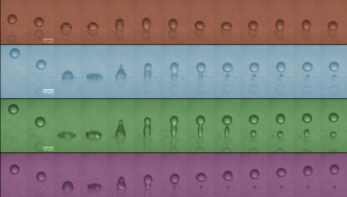Our atmosphere and climate is dominated by the effects of water vapour, which strongly absorbs sunlight. But even after decades of study, scientists struggle to explain how water molecules absorb as much solar radiation as they do. Now Thomas Rizzo of the École Polytechnique Fédérale de Lausanne in Switzerland and colleagues hope that their novel study of excited water molecules will solve the discrepancy and improve our understanding of effects such as global warming (A Callegari et al 2002 Science 297 993).

Water vapour absorbs radiation at many wavelengths, but it absorbs infrared and ultraviolet radiation – which are strongly emitted by the Sun – particularly well. The different energy transitions in molecules of water vapour allow it to absorb radiation of certain wavelengths, and when light is shone through this vapour and dispersed using a prism, this absorption shows up as dark lines in the resulting spectrum.
Many researchers have determined the positions and intensities of these absorption lines by measuring the electric dipole moment of molecules of water vapour. This quantity describes how charge is spread through the molecule, and determines how it absorbs radiation. But the electric dipole moment is tricky to measure using conventional spectroscopy, and the best calculations based on previous results cannot fully explain the observed absorption of solar radiation by water vapour in the atmosphere.
Now Rizzo and colleagues hope that their new results will help to resolve this discrepancy, and provide a benchmark against which to measure earlier calculations. In the first experiment of its kind, the team has measured the electric dipole moment of molecules of water vapour in highly excited states – the states they are in when they absorb solar radiation.
The electric dipole moment is directly linked to the ‘Stark effect’, in which the absorption lines of atoms or molecules split into several thinner lines when an electric field is switched on. Exploiting this effect, Rizzo and colleagues applied an electric field to a collection of water molecules and excited them with a laser pulse.
Stark splitting created a series of lines with very similar wavelengths, so Rizzo’s team used a ‘quantum beat’ method – analogous to the beat effect in acoustics – to measure their wavelengths. This allowed them to calculate the electric dipole moment extremely accurately. “This technique is quite novel and provides stringent tests of calculated dipole moments,” Rizzo told PhysicsWeb.
Rizzo and colleagues hope that their results will help scientists to determine exactly how solar radiation is absorbed in the atmosphere, and lead to a better understanding of energy transport in the atmosphere and its effect on the climate. The findings could also help astronomers to observe sunspots and to understand how light is absorbed by clouds of water vapour in the atmospheres of distant stars.



